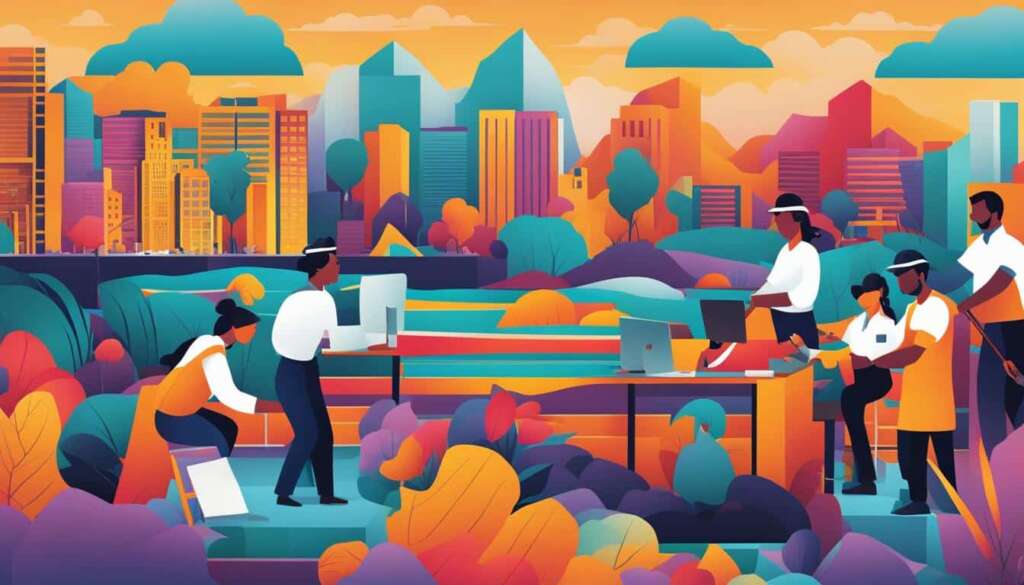Table of Contents
With the rise of the gig economy, flexible work arrangements such as freelance jobs and temporary jobs have become increasingly popular, transforming the way we work and the shape of the modern job market. But what exactly is a gig?
In simple terms, a gig is a temporary job, typically in the context of the entertainment industry. However, in recent years, the meaning of “gig” has broadened to encompass a wide range of flexible work arrangements, including freelance and temporary jobs across different industries, such as marketing, design, and IT.
The gig economy offers a diverse spectrum of flexible work opportunities, allowing professionals to work on projects with different clients, acquire new skills and learn from various experiences. At the same time, it provides businesses with access to a vast pool of skilled professionals who can help them to achieve their goals without the commitment and cost of full-time employees.
Key Takeaways
- The term “gig” has evolved to include various flexible work arrangements such as freelance and temporary jobs.
- The gig economy provides professionals with opportunities to work on different projects, acquire new skills, and gain diverse experiences.
- Businesses can benefit from the gig economy by accessing a pool of talented professionals without the commitment of full-time employees.
- The gig economy has transformed the traditional employment model, creating new opportunities and challenges for both professionals and businesses.
- The gig economy is a growing trend in the modern work landscape, and it is essential to embrace the opportunities it offers and be prepared for the evolving nature of work.
The Essence of Gigs: Exploring Freelance and Temporary Jobs
In today’s gig economy, temporary and freelance work play a critical role in shaping the modern workforce. These types of jobs offer a range of benefits, including flexible schedules, the ability to work on diverse projects, and the freedom to control one’s workload. In this section, we will explore the significance of gig work and its impact on professionals across various industries.
The Gig Economy
The gig economy is defined as a labour market characterized by short-term contracts or freelance work rather than permanent jobs. This flexible work model has disrupted traditional employment and created new opportunities for professionals seeking temporary or part-time work. According to a study conducted by the McKinsey Global Institute, gig workers now represent around 20-30% of the working-age population in the United States and the European Union.
Characteristics of Freelance and Temporary Jobs
Freelance and temporary jobs share several defining characteristics. Firstly, gig workers have more control over their schedule and workload, which allows them to balance work with other aspects of their lives. Additionally, gig work often involves a diverse range of projects, which can help workers build their skills and explore different industries. Finally, freelancers and temporary workers typically enjoy greater independence and autonomy in their work, which can be a significant driver of job satisfaction.
The Rise of Gig Work
Gig work has become increasingly prevalent in recent years, and the trend shows no signs of slowing down. Many companies are embracing the gig economy by hiring freelancers or outsourcing specific tasks to temporary workers. In turn, this has transformed the traditional employment model and created a more dynamic and flexible work landscape. As more professionals seek the benefits of gig work, it is likely that we will continue to see growth in this area.
Understanding the Gig Economy: Key Factors and Trends.
In today’s ever-changing job market, the gig economy has become an essential part of the workforce landscape. The gig economy is a term used to describe a flexible work model where individuals work on a temporary or freelance basis, instead of being employed permanently by a single company. The gig economy has contributed significantly to the rise of freelance and temporary work opportunities, creating a new paradigm for both employers and workers.
There are different types of gig workers, including those who work in the sharing economy, such as Uber or Airbnb, and those who provide freelance services through online platforms, such as Upwork and Freelancer. Gig work offers several benefits, including flexible schedules, the ability to work remotely, and the opportunity to work on multiple projects at once.
The role of gig platforms has been critical in connecting freelancers with clients in need of their services. These platforms enable gig workers to showcase their skills and connect with potential employers from all over the world, providing them with access to a broader range of job opportunities.
Key Trends Shaping the Gig Economy
The gig economy has seen significant growth in recent years, and several exciting trends have emerged. One such trend is the rise of remote work. As more companies embrace remote work, gig workers can work for clients anywhere in the world without having to move to a specific location.
Another notable trend is the increased use of digital platforms for gig work. As technology advances, it has become easier for gig workers to find work and complete their projects. Digital platforms have made it easier for businesses to connect with freelancers and manage their projects efficiently.
Finally, there has been a growing trend of gig-to-permanent transition, where companies hire gig workers full-time after a successful project or contract. This has provided gig workers with more job security and stability, creating a win-win situation for both the employers and employees.
“The gig economy is not only shaping the way people work but also creating new business models, new forms of work, and disrupting traditional employment practices” – Deloitte
Conclusion
In conclusion, this comprehensive guide has provided valuable insights into the concept of gigs and their significance in the modern work landscape. We’ve explored the gig economy, freelance and temporary jobs, and the key trends driving this flexible work model. As the gig economy continues to grow, it’s essential for professionals to embrace the opportunities it offers and be prepared for the evolving nature of work.
With the rise of digital platforms and remote work, the gig economy is becoming more prevalent in various industries. It offers professionals the flexibility to work on multiple projects and gain experience in different areas while maintaining their independence. However, it also presents challenges such as income instability and lack of benefits, which must be carefully considered before embarking on a gig career.
Overall, the gig economy provides a unique and evolving landscape for professionals to explore. By understanding the concept of gigs and staying up to date with the latest trends, individuals can make informed decisions about their career paths and take advantage of the opportunities this flexible work model has to offer.
FAQ
What is a gig?
A gig refers to a freelance or temporary job in the flexible work landscape. It is a short-term engagement where individuals offer their services or skills for a specific project or period of time.
What are freelance jobs?
Freelance jobs are independent, project-based work opportunities where individuals work on a contractual basis for different clients. Freelancers have the freedom to choose their projects and clients, offering their expertise in exchange for payment.
What are temporary jobs?
Temporary jobs are positions that are typically of short duration, ranging from a few days to several months. These roles may be filled to meet specific project requirements, cover staff absences, or address seasonal demands.
How does the gig economy impact the workforce?
The gig economy has transformed the traditional employment model by providing individuals with greater flexibility and autonomy. It has created new opportunities for professionals to work on diverse projects, choose their own schedules, and explore multiple career paths.
What are the benefits of freelance and temporary jobs?
Freelance and temporary jobs offer several benefits, including flexibility in terms of time and location, exposure to a variety of projects and industries, the ability to set your own rates, and the opportunity to build a diverse portfolio of work.
How do gig platforms connect freelancers with clients?
Gig platforms are online platforms that act as intermediaries, connecting freelancers with clients seeking specific services. These platforms provide a marketplace where individuals can showcase their skills, negotiate terms, and secure freelance work.
What are some key trends in the gig economy?
Some key trends in the gig economy include the rise of remote work, the growing popularity of digital platforms for job matching, and the increasing number of individuals transitioning from gig work to permanent positions.
How can professionals benefit from the gig economy?
Professionals can benefit from the gig economy by tapping into a wide range of opportunities, gaining valuable experience, expanding their network, and adapting to the changing nature of work. Embracing the gig economy can provide individuals with flexibility and the chance to pursue their passion.













